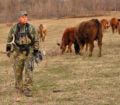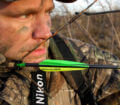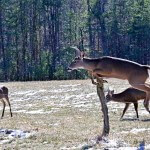Editor’s Note: A brown muzzle eased out of the thick cover as a deer’s eyes appeared. Finally a wide, high rack came into view. Cautiously, nervously, the buck took two steps into the road. A rifle reported. The buck stumbled and fell. The hunter had his trophy. Let’s look at some of the most-productive places where you can take a buck this hunting season.
 One fall some years ago, several hunting buddies had waded a swamp late in the season and had already passed a small dry spot where the top of a downed tree on the ground was above the water. They had walked 10 feet from that place when one hunter looked back over his shoulder, took aim with his rifle and squeezed the trigger. A nice 8 point rolled off a little mound and into the water. When they reached the buck, they asked their buddy how he had seen the deer. “I noticed some movement on a tiny patch of ground,” he said. “As I looked closely, I spotted the deer’s antlers. In my riflescope, I could see the buck watching the rest of you walking. Apparently he hadn’t seen me or perhaps thought I would walk on past him. I guess the buck knew you were walking away from him and posed no threat to him. He never saw me when I raised my rifle.”
One fall some years ago, several hunting buddies had waded a swamp late in the season and had already passed a small dry spot where the top of a downed tree on the ground was above the water. They had walked 10 feet from that place when one hunter looked back over his shoulder, took aim with his rifle and squeezed the trigger. A nice 8 point rolled off a little mound and into the water. When they reached the buck, they asked their buddy how he had seen the deer. “I noticed some movement on a tiny patch of ground,” he said. “As I looked closely, I spotted the deer’s antlers. In my riflescope, I could see the buck watching the rest of you walking. Apparently he hadn’t seen me or perhaps thought I would walk on past him. I guess the buck knew you were walking away from him and posed no threat to him. He never saw me when I raised my rifle.”
 As the hunters dragged the buck through the water and back to camp, they all thought about how-many bucks they’d probably walked by each time they went into a swampy area. A hunting friend once said that since an older age-class buck easily could see or hear hunters in a swamp, then more than likely the buck wouldn’t get out of his bed. However, if he no longer could see or hear the hunters, that buck would become nervous and might come out of his bed to look for the hunters.
As the hunters dragged the buck through the water and back to camp, they all thought about how-many bucks they’d probably walked by each time they went into a swampy area. A hunting friend once said that since an older age-class buck easily could see or hear hunters in a swamp, then more than likely the buck wouldn’t get out of his bed. However, if he no longer could see or hear the hunters, that buck would become nervous and might come out of his bed to look for the hunters.
If your hunting grounds flood each year, more than likely, there may be more than one high-ground spot in that flooded timber. To hunt effectively and not spook the deer you’re hoping to take, pick out two or three high-ground places that you want to hunt and make those dry spots hunting places with deer attractant. Set-up a tree stand within sight of the high ground with liquid or powdered attractant on it. Then when your area has a favorable wind, go to that tree stand site before daylight, get into your tree stand as quickly as possible, and watch that high-ground spot for deer to come in to the attractant. By having several different high-ground spots in various areas, you can hunt a different attractant site each day you hunt. More than likely your attractant sites on high ground will draw-in more deer than any-other high spot on the property.
When you walk through wetlands like flooded timber or swamps, and you reach a thicket, stand near that thicket. Don’t move or say a word. Often the buck you are looking for will stand-up and search for you. Flood-plain bucks are some of the biggest and wariest deer to be found anywhere in the nation. In the wintertime, hard rains often fall and inundate forests, pastures and other regions with water. Rivers and streams overflow their banks, and the ground that the water spills over is revitalized with rich soil. River-bottom hardwoods produce the nut crops on which deer feed. Briar patches and thickets provide both food and shelter for whitetails in wetland areas, and you can bag big bucks there.

 To learn more information on women hunting, check out John E. Phillips’ book, “Outdoor Women’s Hall of Fame” (https://www.amazon.com/Outdoor-Womens-Hall-Fame-Premier-ebook/dp/B0771VP16V). To receive your free book on “How to Make Venison Jerky,” go to https://www.emailmeform.com/builder/form/Ece3UZVcOo52cKPJcL.
To learn more information on women hunting, check out John E. Phillips’ book, “Outdoor Women’s Hall of Fame” (https://www.amazon.com/Outdoor-Womens-Hall-Fame-Premier-ebook/dp/B0771VP16V). To receive your free book on “How to Make Venison Jerky,” go to https://www.emailmeform.com/builder/form/Ece3UZVcOo52cKPJcL.









